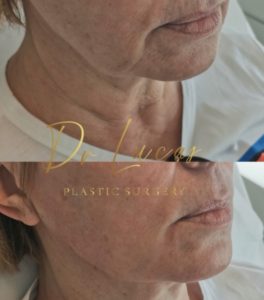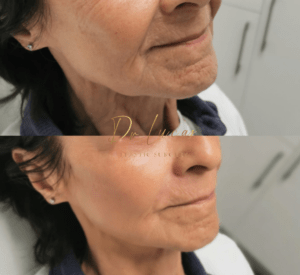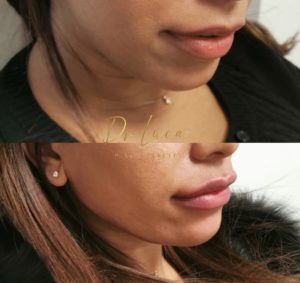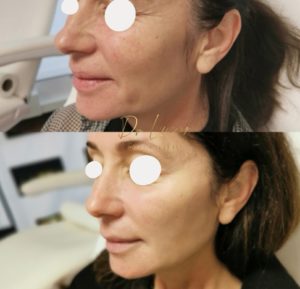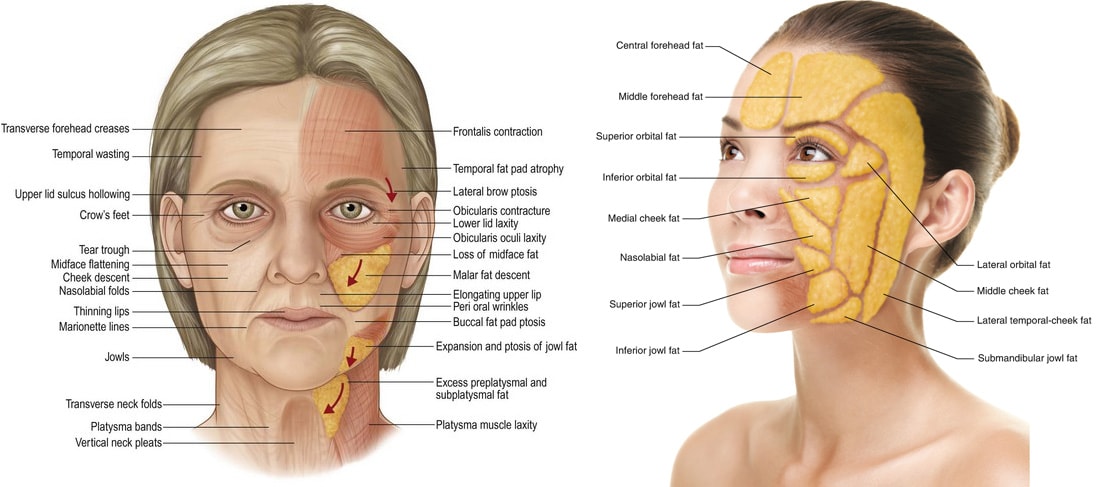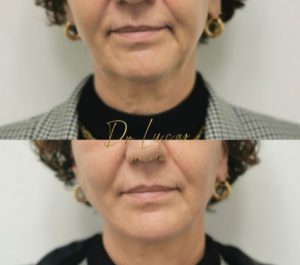Anatomy and ideal proportion :
A young face is defined by an overall “V” shape given by full cheeks and well-marked cheekbones associated with a well-defined facial oval.
Mechanism of facial aging:
Facial aging is due to sagging of the skin and stretching of the various structural ligaments but also to a relaxation of the musculoaponeurotic system (SMAS). The face sinks downwards with the appearance of nasolabial folds and jowls. This loss of elasticity leading to skin sagging is combined with a melting of the various fatty areas of the face over time, which leads to a loss of support.
When the sagging (ptosis) and excess skin are too great, surgical lifting is preferable. Non-surgical lifting with threads or hyaluronic acid (the two can also be combined) can be an interesting alternative for patients with moderate ptosis and moderate skin excess, who do not want to have the social eviction that a surgical lifting would have.
The principle of the hyaluronic acid facelift (“liquid lfiting”) is to inject the support areas that have undergone tissue melting over time: lateral part of the cheekbone, pretragal area (in front of the ear), lateral part of the cheek and vertical branch of the jaw.
Photos of cases with marked key points
The principle of PDO (=polydioxanone) tensioning sutures is to apply a traction force opposite to the relaxation, thanks to the teeth that these tensioning sutures present. These teeth hook the subcutaneous tissue and pull the skin to restore the oval of the face.
Technique :
Hyaluronic acid:
Topical anesthesia with cream and filling with a cannula. The cannula, with its smooth, non-sharp tip, allows for a less painful injection with less hematoma.
Tensor threads:
They are inserted through micro-incisions (0.5 mm), run in tunnels under the skin to the scalp and the tension is adapted to raise the eyebrow. The procedure is performed under local anesthesia, the principle is to make a long tunnel so that the thread has a wide grip and holds longer and to anesthetize the entire path of the tunnel for maximum comfort of the patient, the procedure thus takes 45 to 60 minutes.
Results:
Time to final results:
Concerning hyaluronic acid, the effect is immediate.
Concerning the tensor threads: after a social eviction of 48h, one can see immediately the result with a hypercorrection of a few mm then to see the final result it is necessary to wait approximately 1 week.
Longevity of results :
Hyaluronic acid: 6 – 15 months
Tensor threads: 6 – 12 months
Hyaluronic acid has a theoretically better longevity, but a less important “tensor” effect. The combination of the two techniques is interesting.
Before the operation:
Stop smoking 1 month before surgery
Do not take Aspirin 10 days before surgery, inform Dr. Lucas of any anticoagulant medication (Sintrom, Coumadin, Eliquis, etc.) to arrange for its discontinuation or replacement.
Take Arnica capsules 5 times a day for 5 days before surgery to prevent hematoma.
Contraindications hyaluronic acid: autoimmune diseases, pregnancy, breastfeeding, former silicone injection on the same site
Intervention :
Pain: pain during the procedure will be almost non-existent, with an appropriate anesthesia
Duration of procedure: 60 minutes for each technique
Anesthesia: local
Location: office
Outpatient (without hospitalization)
After the procedure:
Post-operative pain: 1/10 often responding to Dafalgan
Social eviction :
Hyaluronic acid: no (sometimes swelling for a few days)
Tensor threads: 24-48h
Return to work: 1 – 2 days
Resumption of sports: 2 days for hyaluronic acid, 10 days after for the threads
Instructions:
Bed rest without major effort (which can cause the opening of small vessels during effort and lead to a hematoma) for 48 hours
Ice for 2-3 days, as often as possible, to reduce swelling
Take Arnica capsules 5 times a day for 5 days after surgery to prevent hematoma
Stop smoking for good to prolong the effect of the hyaluronic acid and the threads
Hyaluronic acid :
Avoid anti-inflammatory drugs and smoking for 48 hours
Massage areas the next day if you feel irregularities or hard areas for 1 week
Dr Lucas control 2 weeks, 3 months
Tensor threads :
Preventive antibiotic Augmentin 1 g twice a day for 3 days after the operation
Avoid opening the mouth wide and movements that put the threads in traction for 1 week
Disinfection with spray twice a day for 3 days at the entry point of the thread.
Control Dr Lucas D7, 3 weeks, 3 months
Complications
Hyaluronic acid:
– Infection, hematoma, asymmetry, under- or over-correction
– Intravascular injection: necrosis, blindness
Tensor threads:
-Secondary displacement of the thread: the thread, if stimulated too hard during the 7 days following the procedure, may come off.
Nerve or vessel damage: the placement of tension wires must be performed by a doctor with a good knowledge of anatomy, with whom the risk of nerve damage is almost non-existent.
-Hematoma: there may be bruising, which generally disappears within 4 to 5 days maximum.
-Asymmetry
– Discreet folds of the skin: this sometimes happens when the eyebrow has to be significantly raised or when there is a lack of flexibility in the tissues. These folds will disappear in 7 days on average.
– Infection: often treated with antibiotics and local care. Exceptionally, it is necessary to remove the threads when the infection is not controlled despite the previous measures.
Alternative:
When the sagging and excess skin are important or when the patient wishes to have a prolonged result over time, he/she is referred to a minilifting or a surgical lift
